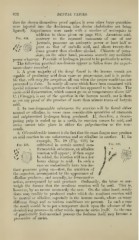Page 816 - My FlipBook
P. 816
826 DENTAL CARIES.
^
thus far shown themselves proof against it even when large quantities
were injected into the duodenum (the ductus choledochus not being
ligated). Experiments Mere made with a number of antiseptics in
addition to those given on page 810. Arsenious acid,
Fig. 434. contrary to the repeated statements of one of our
journals, possesses an antiseptic power at least half as
great as that of carbolic acid, and about twenty-five
times greater than absolute alcohol. Chlorate of potas-
sium, on the other hand, possesses scarcely any available
power whatever. Peroxide of hydrogen proved to be particularly active.
The following practical conclusions appear to follow from the experi-
ments above recorded :
1. A great majority of the fungi found in the human mouth are
capable of producing acid from cane- or grape-sugar, and it is proba-
ble that, icith vei-y few exceptions, all can when the proper conditions are
presented to them. In nearly all cases which have been examined with
special reference to this question the acid has appeared to be lactic. The
acetic-acid fermentation, which cannot go on at temperatures above 35°
C. (Fluegge), is out of the question in the human mouth, nor is there
as yet any proof of the presence of more than minute traces of butyric
acid.
2. In non-fermentable substances the reaction will be found either
neuti'al or alkaline, in some cases considerable quantities of ammonia
and sulphuretted hydrogen being produced. If, therefore, a decom-
posing pulp is sealed up in a tooth, its reaction cannot be acid, and
caries cannot take place in either the pulp-chamber or the root-
canals.
3. Ofconsiderable interest is the fact that the same fungus may produce
an acid reaction in one substratum and an alkaline in another. If, for
example, No. 19 (Fig. 439) be
Fig. 435. cultivated in certain neutral non-
fermentable substances, an alkaline
reaction will appear ; if then sugar
be added, the reaction will in a few
hours change to acid. In such a
case we undoubtedly have two dis-
tinct processes going on—first, the nutrition of
tlie organism, accompanied by the appearance of
alkaline products ; and secondly, its fermentative
action, accompanied by acid products. Ordinarily, the latter so out-
weigh the former that the resultant reaction will be acid. This is,
however, by no means necessarily the case. On the other hand, condi-
tions may readily be produced under which the resultant reaction will
be neutral or alkaline, especially in the human mouth, where so many
different fungi and so various conditions are present. In such a case
the result would be to put a temporary check upon the advance of the
decalcifying process—in otlier words, upon the caries itself. In the case
of particularly foul-mouthed persons the foulness itself may become a
preventive of caries.


